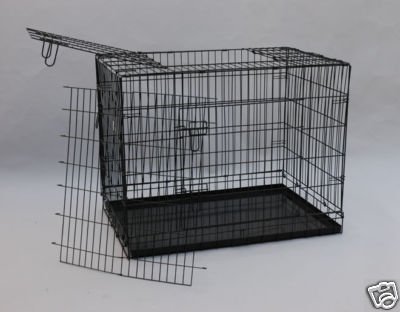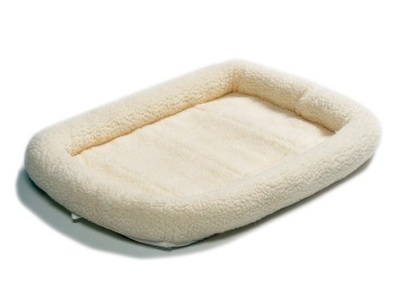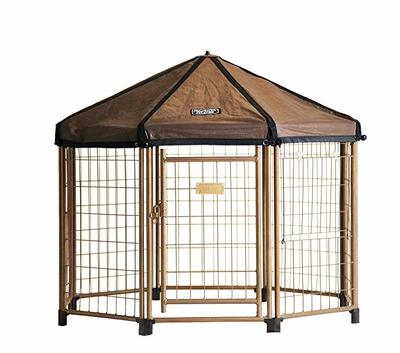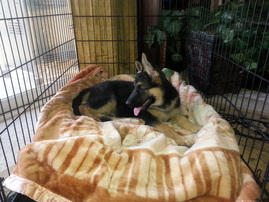Central Coast German Shepherds CCGS
- HOME
-
Puppies
- German Shepherd Puppies FOR SALE
- FAQ about Getting a Puppy from CCGS
- RESERVATION INSTRUCTIONS
- How we raise our puppies
- More on Raising our Puppies
- Why our Breeding Stock come from Europe!
- GERMAN vs AMERICAN
- HEALTH WARRANTY
- TESTIMONIALS
- Socialization
- Purchase Warranty
- Male vs Female Puppy
- FEEDING / GROOMING
- Vaccination Schedule
- Kuranda Beds
- TRAINING >
- LIFE SAVING INFO >
- Ears not standing?
- Recommended Reading
- Why buy from a reputable breeder?
- Coat Type & Coat Colors
- What to look for in a puppy
- When do we wean the puppies
- Adults 4 Sale
- Stud Dogs
- Our FEMALES
- TRAINING
- CONTACT
- STORE
- NuVet
- MEMBERS
- Health Risks
- Our Ranch In the Making
- I am a breeder
- MICROCHIP REGISTRATIONS
- Service Dogs
Crate Training ~ What Size Crate ~ Why Crate Train
Please consider Crate Training and use Exercise Pens (X Pens) for when you can't be supervising your puppy! Use them, don't abuse them. These are training tools that will make your dogs life much more enjoyable. Dogs are den animals. They like to have a place where they can feel safe and you like a place where you know they can't get into trouble.
We use the 32" Tall X 42" Long X 28" Wide crate with a Divider so you can adjust the size while your puppy grows. We recommend a crate that has two doors, one on the front and one on the side. If you use a crate in the car for traveling, the variable doors come in handy. You don't need a crate with a door on the top (as pictured above) , those are best for small breeds.
The Advantek Pet Gazebo MEDIUM ~ The Pet Gazebo will give your dog a little more room to play but still keep him in a controlled space while you are busy with other things. If you don't allow mistakes to happen, you are not working on correcting bad behaviours! Use an X Pen and/or Crate!
Here is a great 5 minute video on some crate training basics. There are a lot more details below the video.
Crate Training
What is a dog crate?
A dog crate is a cage made of wire or molded plastic. I prefer the wire. It's purpose is to provide confinement for reasons of security, safety, housebreaking, protection of household goods, travel or illness. You may think that putting your pet in a crate is mean or inhumane and might cause your pet to resent you or to be psychologically damaged. However, dogs view the world differently than people.
As your dog sees it, the crate is a room of his very own - a "security
blanket". The crate helps to satisfy the "den instinct" inherited from his
den-dwelling ancestors and relatives. Your pet will feel secure, not frustrated
once accustomed to his crate. Your pet wants to please you and you want to
enjoy him. The crate can help you achieve a better relationship with your pet
by preventing unwanted behavior when you aren't available to supervise him.
The advantages of using a crate
With the help of a crate:
Purchasing a crate
Crates can be purchased at pet stores, department stores, and from pet supply
catalogs. Look for a wire crate that includes a removable floor pan. Plastic crates
can also be used, although some dogs will chew the plastic. For your pet's comfort,
look for one with a smooth floor. Purchase crate large enough for your pet to
stretch out on its side and to sit or stand erect. If you have a puppy, it is more
economical to buy a wire crate that will accommodate him as an adult, then
partition it to the right size. We use the 32" Tall X 42" Long X 28" Wide crate. A movable wire or pegboard partition can be made or purchased. Look for a crate that comes with a partition if you have a puppy. Once your puppy is totally crate trained, you will no longer need the partition. You can also just place a box in the back of the crate to make the space in the crate smaller until your puppy grows. Too large a crate can undermine housebreaking because your pet may eliminate at one end of the crate and lie down at the other. If he is eliminating in his crate, make his space in the crate smaller until the elimination stops (of course, remember, if you just left him in there way too long, it's your fault, not his). Most puppies will cry to go out to go potty if the crate is not too large to be able to move away from the soiled area. For bedding, use an old blanket or buy a washable crate pad. Depending on size and construction, a new crate may cost $100 - 150. This is a bargain compared to the cost of replacing a sofa, woodwork, or carpeting. You can find crates at Lemos Feed and Pet Supply or Pet Co. Both of these suppliers have quality crates. Other department stores and pet supply stores may carry cheaper versions. I don't recommend the cheapest crates as they do not hold up well over time and a really smart dog can escape. If you do go with the cheapest version, you can put zip ties around all of the sides to reinforce the kennel at the corners and gates. You can also purchase used crates on Craigslist.com. If you choose to buy a used crate be sure you sanitize the entire crate well with bleach prior to using it.
Where should I put it?
Dogs are social animals. Place the crate in an area where the family spends a lot of time - kitchen. family room, etc. The top of the crate can serve as extra shelf or table space. At night, move your puppy's crate into your bedroom so you can hear him if he needs to go out.
Crating a puppy
A young puppy should have no problem accepting the crate as his place. Crying
at first is caused, not by the crate, but by adjusting to an unfamiliar household. Do
not reward barking or whining with attention! If you are sure he doesn't need to
eliminate, ignore him until he is quiet, then praise him or take him out of the crate.
Leave a safe chew toy in the crate for your pet. Close your pet in the crate whenever he must be left alone or can't be closely supervised by a responsible
person.
Never crate your pet longer than you know he can wait to eliminate, and
definitely less than 4 hour intervals during the day. If you occasionally must
be gone longer than this, place the crate with the door open in an enclosed
area such as a bathroom or laundry room. Place newspapers on the floor of the
room to facilitate clean-up. Your puppy should soon stop eliminating overnight
and then may be crated in his regular place.
Crate training dogs over 6 months old
Often problem behaviors in this age group result from the pet feeling insecure
when left alone. A crate can actually help alleviate this anxiety, but it must be
introduced gradually and in a positive manner. The dog's first association with
the crate should be pleasant. First secure the door open so that it can't suddenly
shut and frighten the dog. Encourage your pet to enter voluntarily by tossing a treat
into the far end, praising him enthusiastically once he enters, then letting him come
right back out. Once he enters the crate confidently, coax him to lie down and
relax, using food, if necessary. Shut the door briefly, while you sit beside
the crate or when there are people in the room. Again, don't reward barking or
whining, with attention. When you feel your dog will remain quietly in the crate,
leave him alone for 15 - 30 minutes. If all goes well, you can leave him for longer
intervals. Eventually, you may no longer need to shut him in the crate, but he will
probably appreciate still having access to his special place.
Does the crate always work?
Unfortunately, no. There are some animals (usually adults) that can or
will not tolerate this form of confinement. A few will show no desire to keep
the crate clean. But when used correctly, most canines will love their crate.
Use - don't abuse!
What is a dog crate?
A dog crate is a cage made of wire or molded plastic. I prefer the wire. It's purpose is to provide confinement for reasons of security, safety, housebreaking, protection of household goods, travel or illness. You may think that putting your pet in a crate is mean or inhumane and might cause your pet to resent you or to be psychologically damaged. However, dogs view the world differently than people.
As your dog sees it, the crate is a room of his very own - a "security
blanket". The crate helps to satisfy the "den instinct" inherited from his
den-dwelling ancestors and relatives. Your pet will feel secure, not frustrated
once accustomed to his crate. Your pet wants to please you and you want to
enjoy him. The crate can help you achieve a better relationship with your pet
by preventing unwanted behavior when you aren't available to supervise him.
The advantages of using a crate
With the help of a crate:
- You can enjoy peace of mind when leaving your dog alone, knowing that
nothing can be soiled or destroyed and that he is comfortable, safe, and not
developing bad habits.
- You can housebreak your pet more quickly by using the close confinement to
motivate your pet to wait until taken outside, since canines naturally avoid
soiling their den.
- You can travel with your pet without risk of the the dog getting loose and
becoming lost or interfering with safe driving.
- Your dog can enjoy the security and privacy of den of his own to which he
can retreat when tired or stressed.
- Your dog can avoid much of the fear and confusion caused by your reaction to
problem behavior.
- Since he can more easily adapt to staying in unfamiliar places as long as he
has his familiar "security blanket" along, your pet can be included in family
outings, instead of being left behind alone.
Purchasing a crate
Crates can be purchased at pet stores, department stores, and from pet supply
catalogs. Look for a wire crate that includes a removable floor pan. Plastic crates
can also be used, although some dogs will chew the plastic. For your pet's comfort,
look for one with a smooth floor. Purchase crate large enough for your pet to
stretch out on its side and to sit or stand erect. If you have a puppy, it is more
economical to buy a wire crate that will accommodate him as an adult, then
partition it to the right size. We use the 32" Tall X 42" Long X 28" Wide crate. A movable wire or pegboard partition can be made or purchased. Look for a crate that comes with a partition if you have a puppy. Once your puppy is totally crate trained, you will no longer need the partition. You can also just place a box in the back of the crate to make the space in the crate smaller until your puppy grows. Too large a crate can undermine housebreaking because your pet may eliminate at one end of the crate and lie down at the other. If he is eliminating in his crate, make his space in the crate smaller until the elimination stops (of course, remember, if you just left him in there way too long, it's your fault, not his). Most puppies will cry to go out to go potty if the crate is not too large to be able to move away from the soiled area. For bedding, use an old blanket or buy a washable crate pad. Depending on size and construction, a new crate may cost $100 - 150. This is a bargain compared to the cost of replacing a sofa, woodwork, or carpeting. You can find crates at Lemos Feed and Pet Supply or Pet Co. Both of these suppliers have quality crates. Other department stores and pet supply stores may carry cheaper versions. I don't recommend the cheapest crates as they do not hold up well over time and a really smart dog can escape. If you do go with the cheapest version, you can put zip ties around all of the sides to reinforce the kennel at the corners and gates. You can also purchase used crates on Craigslist.com. If you choose to buy a used crate be sure you sanitize the entire crate well with bleach prior to using it.
Where should I put it?
Dogs are social animals. Place the crate in an area where the family spends a lot of time - kitchen. family room, etc. The top of the crate can serve as extra shelf or table space. At night, move your puppy's crate into your bedroom so you can hear him if he needs to go out.
Crating a puppy
A young puppy should have no problem accepting the crate as his place. Crying
at first is caused, not by the crate, but by adjusting to an unfamiliar household. Do
not reward barking or whining with attention! If you are sure he doesn't need to
eliminate, ignore him until he is quiet, then praise him or take him out of the crate.
Leave a safe chew toy in the crate for your pet. Close your pet in the crate whenever he must be left alone or can't be closely supervised by a responsible
person.
Never crate your pet longer than you know he can wait to eliminate, and
definitely less than 4 hour intervals during the day. If you occasionally must
be gone longer than this, place the crate with the door open in an enclosed
area such as a bathroom or laundry room. Place newspapers on the floor of the
room to facilitate clean-up. Your puppy should soon stop eliminating overnight
and then may be crated in his regular place.
Crate training dogs over 6 months old
Often problem behaviors in this age group result from the pet feeling insecure
when left alone. A crate can actually help alleviate this anxiety, but it must be
introduced gradually and in a positive manner. The dog's first association with
the crate should be pleasant. First secure the door open so that it can't suddenly
shut and frighten the dog. Encourage your pet to enter voluntarily by tossing a treat
into the far end, praising him enthusiastically once he enters, then letting him come
right back out. Once he enters the crate confidently, coax him to lie down and
relax, using food, if necessary. Shut the door briefly, while you sit beside
the crate or when there are people in the room. Again, don't reward barking or
whining, with attention. When you feel your dog will remain quietly in the crate,
leave him alone for 15 - 30 minutes. If all goes well, you can leave him for longer
intervals. Eventually, you may no longer need to shut him in the crate, but he will
probably appreciate still having access to his special place.
Does the crate always work?
Unfortunately, no. There are some animals (usually adults) that can or
will not tolerate this form of confinement. A few will show no desire to keep
the crate clean. But when used correctly, most canines will love their crate.
Use - don't abuse!
- Children should be taught that the crate is a special room for the pet and
that they should not pester the dog or pup when it is in the crate or use the
crate as a playhouse.
- The use of a dog crate is NOT RECOMMENDED for a dog regularly left alone all
day. The pet must be well exercised before and after crating.
- If you do not have time to take a puppy or dog outside to eliminate and
exercise as recommended here, you should reconsider getting a dog as a pet.
Crate or no crate, any dog consistently denied the attention and companionship
it craves, may still find ways to express bored anxiety, and stress
- HOME
-
Puppies
- German Shepherd Puppies FOR SALE
- FAQ about Getting a Puppy from CCGS
- RESERVATION INSTRUCTIONS
- How we raise our puppies
- More on Raising our Puppies
- Why our Breeding Stock come from Europe!
- GERMAN vs AMERICAN
- HEALTH WARRANTY
- TESTIMONIALS
- Socialization
- Purchase Warranty
- Male vs Female Puppy
- FEEDING / GROOMING
- Vaccination Schedule
- Kuranda Beds
- TRAINING >
- LIFE SAVING INFO >
- Ears not standing?
- Recommended Reading
- Why buy from a reputable breeder?
- Coat Type & Coat Colors
- What to look for in a puppy
- When do we wean the puppies
- Adults 4 Sale
- Stud Dogs
- Our FEMALES
- TRAINING
- CONTACT
- STORE
- NuVet
- MEMBERS
- Health Risks
- Our Ranch In the Making
- I am a breeder
- MICROCHIP REGISTRATIONS
- Service Dogs



